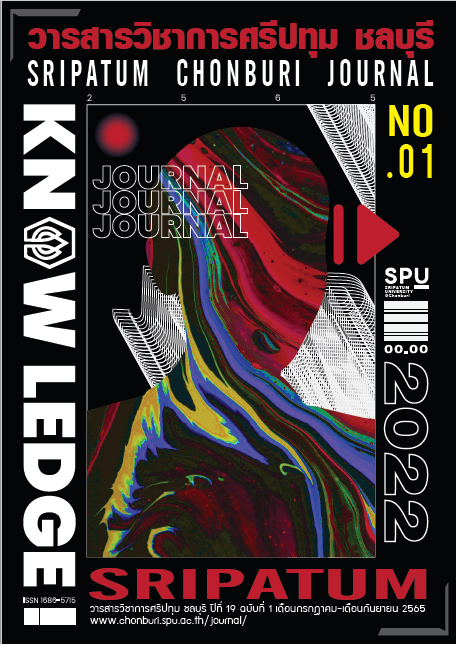THAI TOURISTS’ BEHAVIORS AND OPINIONS TOWARDS CULTURAL TOURISM IN CHACHOENGSAO PROVINCE
Keywords:
Cultural tourism, Behavior and opinionAbstract
The research aimed to study Thai tourists’ behaviors and opinions towards cultural tourism in Chachoengsao Province. The Accidental Sampling method is applied for the research. The research samples were 400 Thai tourists who visited Chachoengsao for cultural tourism activities. The research tool was a questionnaire, which had the reliability is .80. Data were analyzed using frequency, percentage, mean and standard deviation.
The results showed that there were three groups of tourists visiting Chachoengsao province who paid respect to the Buddha. 200 tourists (50.00%) visited Wat Samanrattaram, 150 tourists (37.50%) visited Wat Sothornwararamworraviharn, and 50 tourists (12.50%) visited Way Huasuan (Lamomprachasan). There were 225 participants (63.80%) from outside the province and 145 participants (36.30%) within the province. 214 participants (53.50%) were traveling with the family, 148 participants (37.00%) were with friends and 32 participants (8.00%) were couples. Advertisement, family, and friends were the channels to perceive tourism information in Chachoengsao province, respectively 45.00%, 40.50%, and 28.50%. The reasons why they visited the temples in Chachoengsao province were its sacredness (75.30%), beauty (17.00%), and famous (7.80%), respectively. 376 samples (94.00%) were willing to visit again, while 24 samples (6.00%) were uncertain. 388 samples (97.00%) revisited the province, though 12 samples (3.00%) would not probably return. Regrading Thai tourists’ opinions toward cultural tourism in Chachoengsao province, it was found that faith in the temples was ( = 4.65) and the temple was the center of the goodness (
= 4.56). It is followed by the temples that have been cleaned from drugs (
= 4.47), the temples are used for mental discipline (
= 4.44), and there is enough clear useful information at tourist sites (
= 4.22).
References
กรรณิกา คำดี. (2558). วัดและศาสนสถานในมิติของการท่องเที่ยว. วารสารบัณฑิตศึกษา มนุษยศาสตร์และสังคมศาสตร์ มหาวิทยาลัยขอนแก่น, 4(2) หน้า 175-191.
จุฑาภรณ์ ทองเพ็ง. (2554). ความคิดเห็นของนักท่องเที่ยวที่มีต่อการจัดการการท่องเที่ยวเชิงวัฒนธรรมของวัดโสธรวราราวรวิหาร จังหวัดฉะเชิงเทรา. ปริญญา
รัฐประศาสนศาสตรมหาบัณฑิต สาขาวิชาการจัดการภาครัฐและภาคเอกชน, วิทยาลัยการบริหารรัฐกิจ มหาวิทยาลัยบูรพา.
ธรรญชนก คำแก้ว. (2555). รายงานวิจัยการวิเคราะห์ความพึงพอใจของนักเที่ยวที่มีต่อแหล่งท่องเที่ยวเชิงวัฒนธรรมประเภทโบราณสถาน: กรณีศึกษา พระอารามหลวง
ในเขตอำเภอเมือง จังหวัดเชียงใหม่. คณะเศรษฐศาสตร์ มหาวิทยาลัยแม้โจ้.
ธฤษวรรณ มาตกุล. (2556). แรงจูงใจของนักท่องเที่ยวชาวไทยเชื่อมโยงสู่เชิงวัฒนธรรมอีสาน กรณีศึกษา วัดศิลาอาสน์ (ภูพระ) จังหวัดชัยภูมิ. การศึกษาอิสระปริญญา
บริหารธุรกิจมหาบัณฑิต สาขาการจัดการการท่องเที่ยว, คณะวิทยาการจัดการ มหาวิทยาลัยขอนแก่น.
ผณินทรา ธนะเพ็ชร. (2556). พฤติกรรมนักท่องเที่ยวชาวไทยในการท่องเที่ยวเชิงพุทธ กรณีศึกษาวัดป่าธรรมอุทยาน อำเมือง จังหวัดขอนแก่น. การศึกษาอิสระปริญญา
บริหารธุรกิจมหาบัณฑิต สาขาวิชาการจัดการการท่องเที่ยว, คณะวิทยาการจัดการ มหาวิทยาลัยขอนแก่น.
พระจำนงค์ ผมไผ, ยุภาพร ยุภาศ และภักดี โพธิ์สิงห์. (2563). วัดกับการส่งเสริมการท่องเที่ยวบนเส้นทางลุ่มน้ำโขง. วารสารสังคมศาสตร์และมานุษยวิทยาเชิงพุทธ,
(5) หน้า 158-170 .
พระอธิการภูวไนย จับใจนาย. (2558). ปัจจัยที่มีผลต่อความสำเร็จของการจัดการท่องเที่ยวเชิงศาสนาและวัฒนธรรม กรณีศึกษาวัดหิรัญญาวาส ตำบลเกาะช้าง อำเภอ
แม่สาย จังหวัดเชียงราย. การค้นคว้าอิสระปริญญารัฐประศาสนศาสตรมหาบัณฑิต สำนักวิชาศิลปศาสตร์ มหาวิทยาลัยแม่ฟ้าหลวง.
ภัทร์ฐิตา ศิรอัครพงศ์. (2557). พฤติกรรมของนักท่องเที่ยวในการท่องเที่ยววัดพระธาตุลำปางหลวง. การค้นคว้าอิสระปริญญาเศรษฐศาสตรมหาบัณฑิต
คณะเศรษฐศาสตร์ บัณฑิตวิทยาลัย มหาวิทยาลัยเชียงใหม่.
ยุทธศักดิ์ สุภสร. (2565). ททท.ดึง “ใหม่ ดาวิกา” ชวนเที่ยวไทย ตั้งเป้าสร้างรายได้ 6.56 แสนล้านบาท (ออนไลน์). ไทยรัฐออนไลน์. เข้าถึงได้จาก:
https://www.thairath.co.th/business/economics/2362685 [2565, 9 เมษายน].
ราณี อิสิชัยกุล. (2557). การจัดการการท่องเที่ยวเฉพาะทาง. นนทบุรี: มหาวิทยาลัยสุโขทัยธรรมาธิราช.
อนุชา นาคาศัย. (2564). ททท. เปิดตัวโครงการ WAT “ศรัทธานำทาง เส้นทางนำเที่ยว” พร้อมเสนอการสร้างสรรค์สินค้าการท่องเที่ยวเพื่อตอบโจทย์พฤติกรรมและ
ความสนใจของนักท่องเที่ยว (ออนไลน์). กระทรวงการท่องเที่ยวและกีฬา. เข้าถึงได้จาก: https://www.mots.go.th/news-view.php?nid=13290 [2565, 3
มีนาคม].
อิทธิพล คุณปลื้ม. (2564). ททท. เปิดตัวโครงการ WAT “ศรัทธานำทาง เส้นทางนำเที่ยว” พร้อมเสนอการสร้างสรรค์สินค้าการท่องเที่ยวเพื่อตอบโจทย์พฤติกรรม
และความสนใจของนักท่องเที่ยว (ออนไลน์). กระทรวงการท่องเที่ยวและกีฬา. เข้าถึงได้จาก: https://www.mots.go.th/news-view.php?nid=13290 [2565,
มีนาคม].
Cochran, William G. (1997). Sampling Techniques. New York, NY: John Wiley & Son.
Cronbach, Lee J. (1990). Essentials of psychological testing (5th ed.). New York, NY: Harper Collins.
Downloads
Published
Issue
Section
License

This work is licensed under a Creative Commons Attribution-NonCommercial-NoDerivatives 4.0 International License.
บทความทุกบทความเป็นลิขสิทธิ์ของวารสารวิชาการศรีปทุม ชลบุรี



